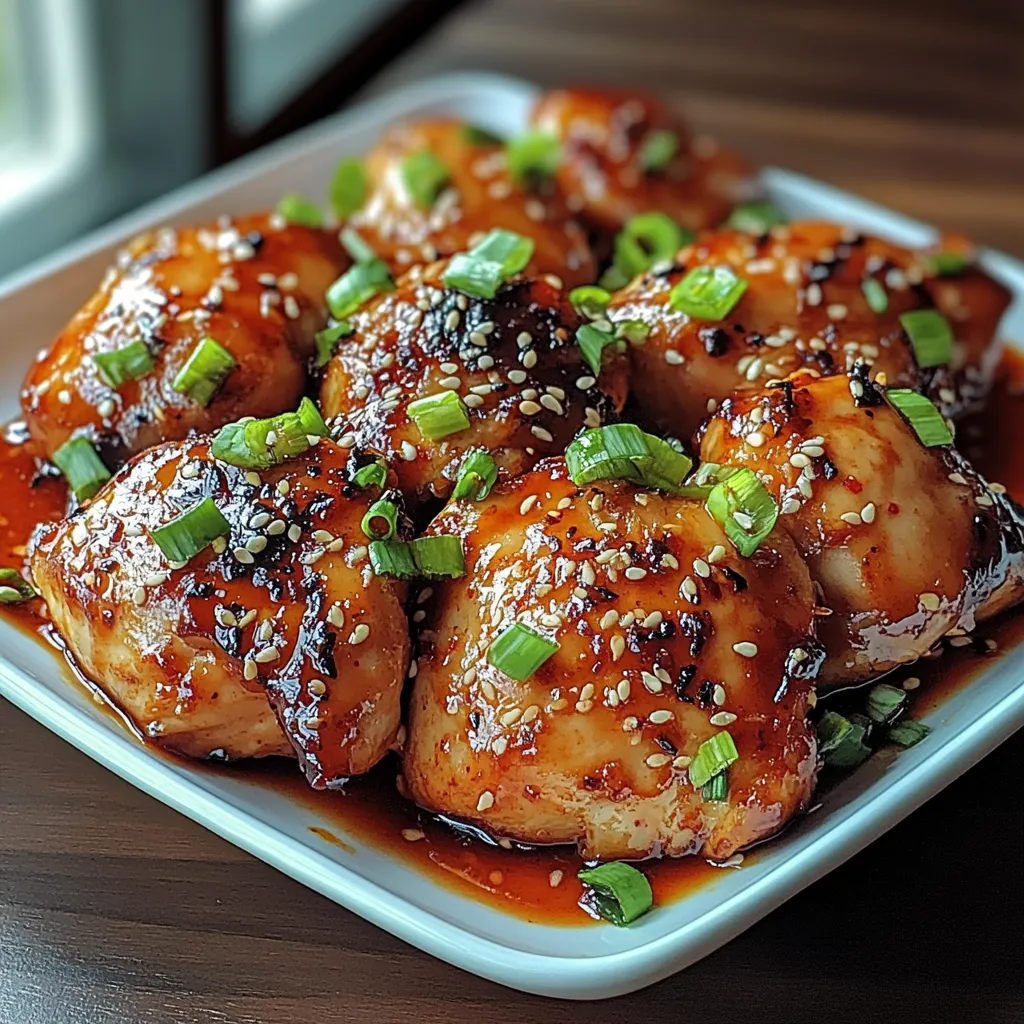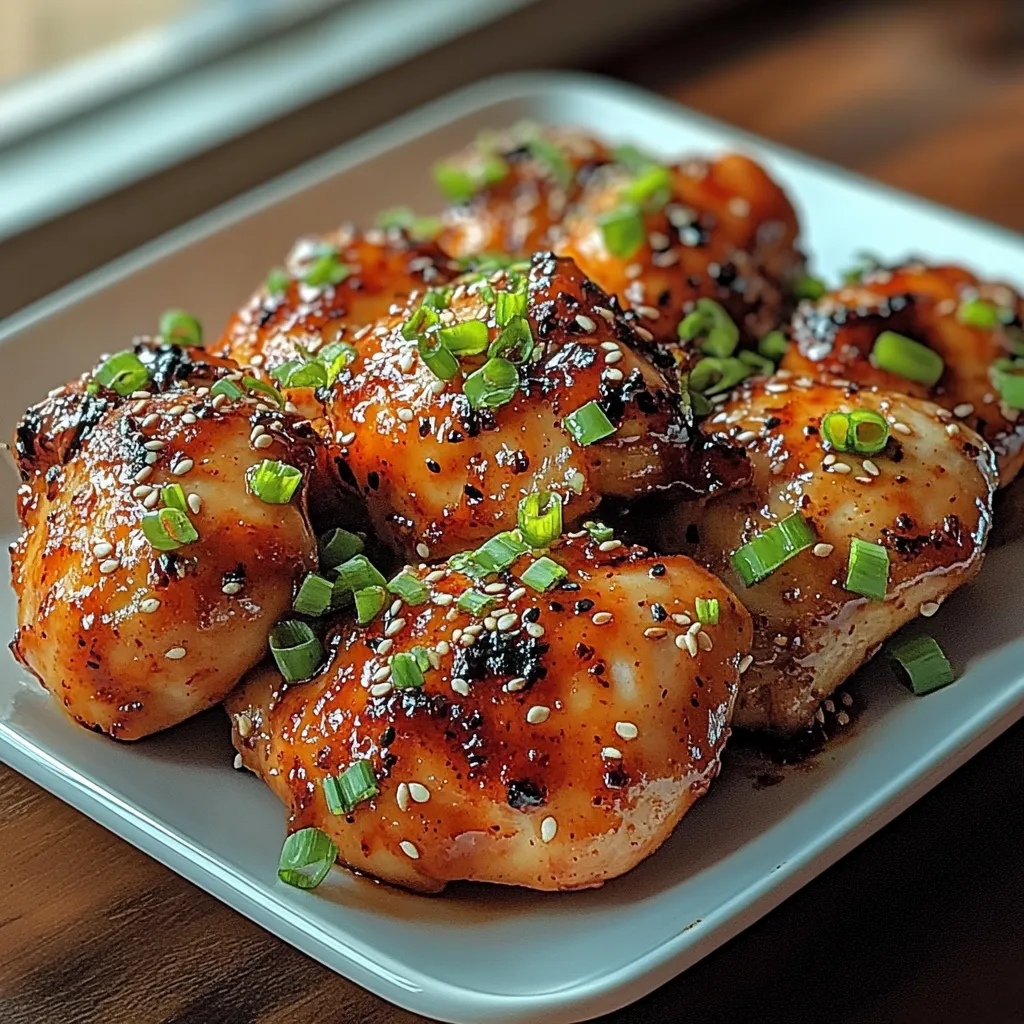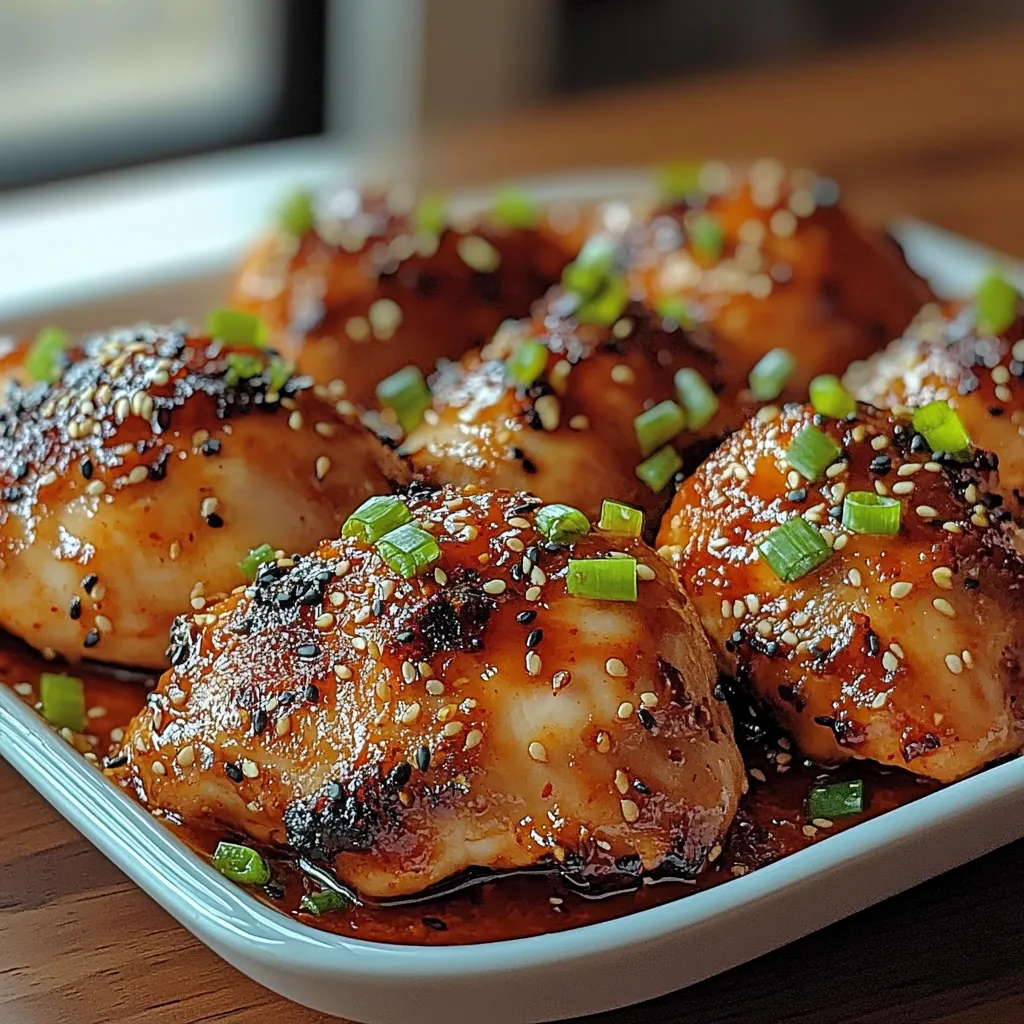 Pin it
Pin it
This spicy gochujang chicken transforms humble chicken thighs into an addictive, flavor-packed meal that balances heat, sweetness, and umami. After discovering Korean cuisine during my travels, I became obsessed with recreating this dish at home and finally perfected this version that rivals my favorite restaurant's.
I first made this recipe when hosting friends for dinner and was nervous about the spice level. It was an instant hit with everyone asking for the recipe, and now it's my go-to impressive weeknight dinner that never fails to satisfy.
Ingredients
- Boneless skinless chicken thighs: They remain juicy and tender even with high-heat cooking
- Gochujang paste: The star ingredient providing complex sweet-spicy flavor look for authentic Korean brands
- Soy sauce: Adds umami depth and balances the spiciness
- Rice vinegar: Provides essential acidity to brighten all flavors
- Honey: Balances the heat with natural sweetness
- Fresh garlic and ginger: Aromatic foundations that make the dish sing
- Sesame oil: Adds nutty richness that's distinctly Asian
- Green onions and sesame seeds: Provide fresh crunch and visual appeal
Step-by-Step Instructions
- Marinate the Chicken:
- Combine gochujang, soy sauce, rice vinegar, honey, minced garlic, grated ginger, and sesame oil in a large bowl until completely smooth. Add chicken thighs and massage the marinade into every crevice. Allow to marinate for at least 30 minutes but for the best flavor, aim for 2 hours. The marinade works its magic by tenderizing the meat while infusing it with complex flavors.
- Prepare the Pan:
- Heat vegetable oil in a large skillet over medium-high heat until it shimmers but doesn't smoke. This stage is crucial for achieving the perfect sear. Remove chicken from marinade but save every drop of that precious liquid for later. Season chicken lightly with salt and pepper.
- Cook the Chicken:
- Place chicken in the hot pan without overcrowding ensuring each piece has space allows for proper browning. Cook undisturbed for 5-7 minutes until deeply golden, then flip and cook another 5-7 minutes. The caramelization of the sugars in the marinade creates incredible depth of flavor. Check that internal temperature reaches 165°F for food safety.
- Create the Sauce:
- Transfer cooked chicken to a clean plate and pour reserved marinade into the same skillet. Use a wooden spoon to scrape up all the flavorful browned bits from the pan these contain concentrated flavor. Simmer the sauce for 2-3 minutes until it thickens slightly and coats the back of a spoon. The heat kills any bacteria from the raw chicken marinade.
- Combine and Serve:
- Return chicken to the skillet and gently toss to coat each piece evenly in the glossy sauce. Allow it to simmer together for 1-2 minutes so the chicken reabsorbs some of that intensified flavor. The sauce should cling to the chicken creating a beautiful glaze.
- Garnish:
- Transfer to a serving platter and shower with sliced green onions and sesame seeds. The fresh bite of green onion cuts through the richness while sesame seeds add textural contrast and visual appeal.
 Pin it
Pin it
Gochujang is truly the heart of this recipe. I discovered it years ago at a Korean market and was initially intimidated by its fiery color, but now my kitchen is never without it. The fermentation process gives it a complexity that simply cannot be replicated with other chili pastes.
Storing Leftovers
This gochujang chicken actually improves overnight as the flavors continue to meld in the refrigerator. Store in an airtight container for up to 4 days. When reheating, add a splash of water to the pan to loosen the sauce and prevent it from becoming too thick. For the best texture, reheat gently on the stovetop rather than using a microwave which can toughen the meat.
Easy Substitutions
If you can't find gochujang, you can approximate the flavor (though it won't be quite the same) by mixing 1 tablespoon tomato paste, 1 tablespoon red pepper flakes, 1 teaspoon miso paste, and a pinch of sugar. For a gluten-free version, use tamari instead of soy sauce and check that your gochujang is wheat-free. Chicken breasts can substitute for thighs but reduce cooking time by about 2 minutes per side to prevent drying out.
Serving Suggestions
While this chicken is delicious on its own, I love serving it alongside steamed rice to soak up the incredible sauce. For a complete meal, add quick pickled vegetables like thinly sliced cucumbers tossed with rice vinegar and a pinch of sugar. A simple side of sautéed bok choy or spinach provides a nice contrast to the rich, spicy chicken. For casual entertaining, slice the chicken and serve in lettuce wraps with extra sauce on the side.
 Pin it
Pin it
This recipe will become a staple in your dinner rotation, delivering restaurant-quality results with minimal effort.
Frequently Asked Questions
- → What is gochujang and where can I find it?
Gochujang is a Korean fermented chili paste made from red chili powder, glutinous rice, fermented soybeans, and salt. It has a unique sweet-spicy-umami flavor. You can find it in Asian grocery stores, international food sections of supermarkets, or online specialty retailers.
- → Can I use chicken breast instead of thighs?
Yes, you can substitute chicken breasts for thighs. However, be aware that chicken breasts cook faster and can dry out more easily. Reduce the cooking time to about 4-5 minutes per side and consider using a meat thermometer to ensure they reach 165°F (74°C) without overcooking.
- → How spicy is this dish, and can I adjust the heat level?
The spice level is moderately hot due to the gochujang. To make it milder, reduce the amount of gochujang to 1 tablespoon and increase the honey to 1.5 tablespoons. For more heat, add 1 teaspoon of Korean chili flakes (gochugaru) or a small amount of sriracha sauce.
- → What side dishes pair well with spicy gochujang chicken?
This chicken pairs wonderfully with steamed rice, which helps balance the spice. Other complementary sides include kimchi, quick-pickled vegetables, cucumber salad, or a simple slaw with a sesame dressing. For a complete Korean-inspired meal, serve with banchan (small side dishes) like spinach namul or bean sprouts.
- → Can I prepare this dish ahead of time?
Yes! You can marinate the chicken up to 24 hours in advance for even deeper flavor. The finished dish reheats well and can be stored in an airtight container in the refrigerator for up to 3 days. When reheating, add a splash of water to the sauce to prevent it from becoming too thick.
- → Is there a vegetarian alternative to this dish?
Absolutely! The same marinade works beautifully with firm tofu, tempeh, or seitan. For tofu, press it first to remove excess moisture, then cut into slabs, marinate, and pan-fry until golden. You can also use the sauce on roasted cauliflower or eggplant for a vegetable-forward option.
